Nurse Turnover: Patient Safety, Leadership, and Professional Standards
VerifiedAdded on 2022/08/13
|8
|1646
|77
Report
AI Summary
This report delves into the multifaceted issue of nurse turnover and its profound impact on patient safety and the overall quality of healthcare. It begins by highlighting the significant rates of nurse turnover and its detrimental effects, including reduced productivity and compromised patient care. The report explores the correlation between nurse turnover and patient safety, emphasizing the importance of professional standards of practice in mitigating turnover-related issues. It further examines the crucial roles of nursing leaders and managers in addressing turnover, including the implementation of effective strategies and transformational leadership styles. The report concludes by emphasizing the need for healthcare systems to adopt proactive measures, such as rewarding nurses, providing comprehensive training, and fostering a supportive work environment to reduce nurse turnover and enhance patient outcomes. The report uses several academic sources to support its findings.

NURSING 0
Nurse Turnover
Nurse Turnover
Paraphrase This Document
Need a fresh take? Get an instant paraphrase of this document with our AI Paraphraser
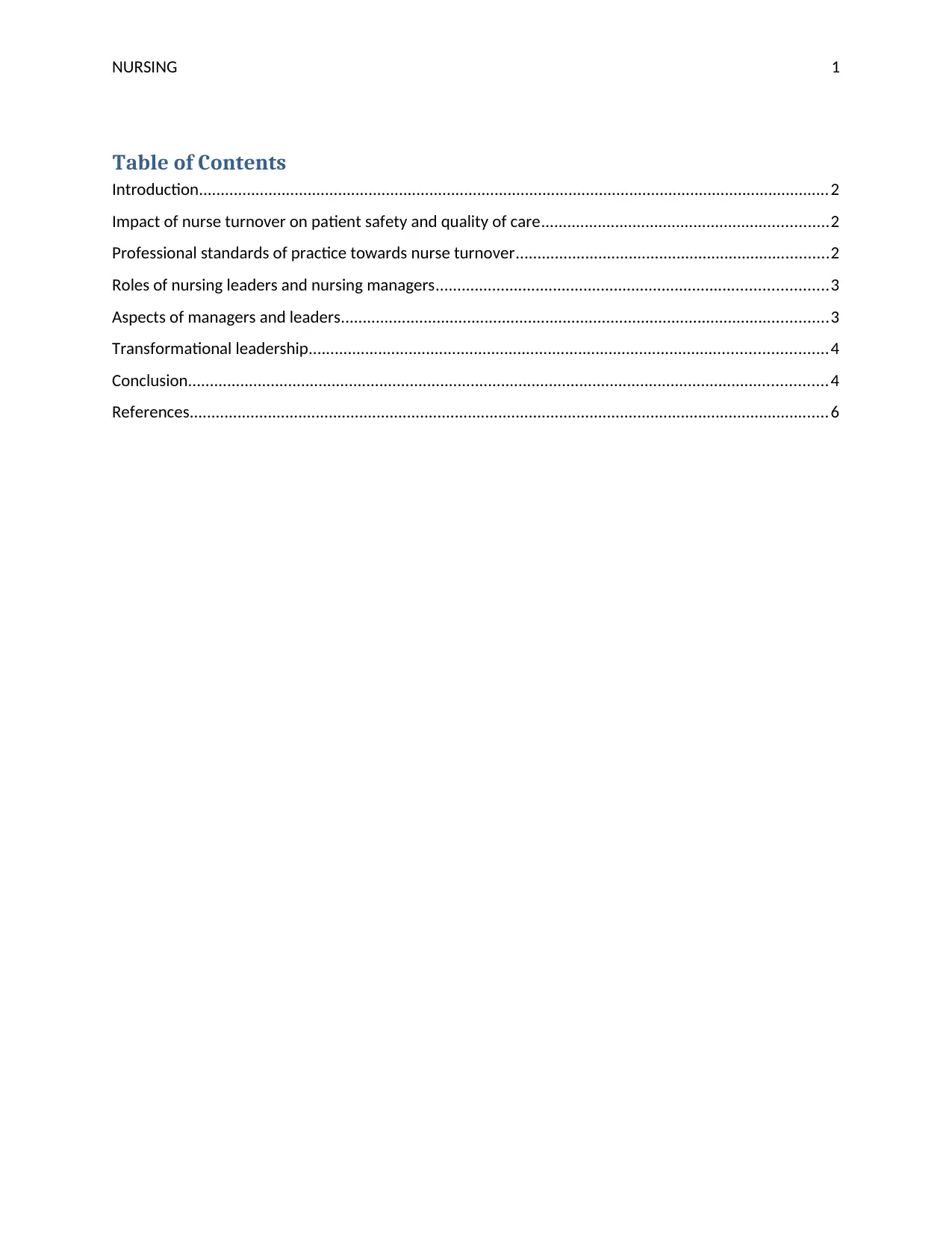
NURSING 1
Table of Contents
Introduction.................................................................................................................................................2
Impact of nurse turnover on patient safety and quality of care..................................................................2
Professional standards of practice towards nurse turnover........................................................................2
Roles of nursing leaders and nursing managers..........................................................................................3
Aspects of managers and leaders................................................................................................................3
Transformational leadership.......................................................................................................................4
Conclusion...................................................................................................................................................4
References...................................................................................................................................................6
Table of Contents
Introduction.................................................................................................................................................2
Impact of nurse turnover on patient safety and quality of care..................................................................2
Professional standards of practice towards nurse turnover........................................................................2
Roles of nursing leaders and nursing managers..........................................................................................3
Aspects of managers and leaders................................................................................................................3
Transformational leadership.......................................................................................................................4
Conclusion...................................................................................................................................................4
References...................................................................................................................................................6
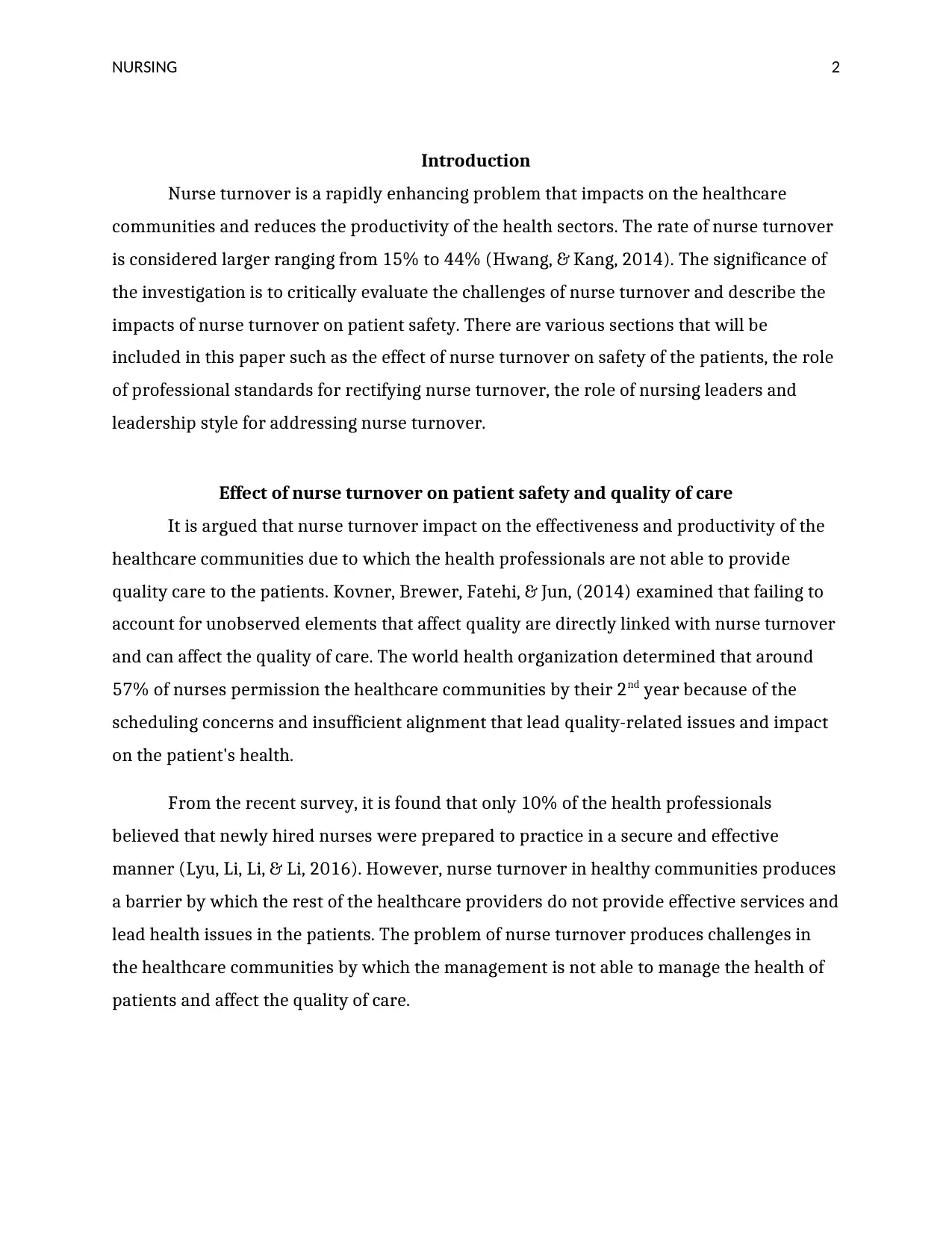
NURSING 2
Introduction
Nurse turnover is a rapidly enhancing problem that impacts on the healthcare
communities and reduces the productivity of the health sectors. The rate of nurse turnover
is considered larger ranging from 15% to 44% (Hwang, & Kang, 2014). The significance of
the investigation is to critically evaluate the challenges of nurse turnover and describe the
impacts of nurse turnover on patient safety. There are various sections that will be
included in this paper such as the effect of nurse turnover on safety of the patients, the role
of professional standards for rectifying nurse turnover, the role of nursing leaders and
leadership style for addressing nurse turnover.
Effect of nurse turnover on patient safety and quality of care
It is argued that nurse turnover impact on the effectiveness and productivity of the
healthcare communities due to which the health professionals are not able to provide
quality care to the patients. Kovner, Brewer, Fatehi, & Jun, (2014) examined that failing to
account for unobserved elements that affect quality are directly linked with nurse turnover
and can affect the quality of care. The world health organization determined that around
57% of nurses permission the healthcare communities by their 2nd year because of the
scheduling concerns and insufficient alignment that lead quality-related issues and impact
on the patient's health.
From the recent survey, it is found that only 10% of the health professionals
believed that newly hired nurses were prepared to practice in a secure and effective
manner (Lyu, Li, Li, & Li, 2016). However, nurse turnover in healthy communities produces
a barrier by which the rest of the healthcare providers do not provide effective services and
lead health issues in the patients. The problem of nurse turnover produces challenges in
the healthcare communities by which the management is not able to manage the health of
patients and affect the quality of care.
Introduction
Nurse turnover is a rapidly enhancing problem that impacts on the healthcare
communities and reduces the productivity of the health sectors. The rate of nurse turnover
is considered larger ranging from 15% to 44% (Hwang, & Kang, 2014). The significance of
the investigation is to critically evaluate the challenges of nurse turnover and describe the
impacts of nurse turnover on patient safety. There are various sections that will be
included in this paper such as the effect of nurse turnover on safety of the patients, the role
of professional standards for rectifying nurse turnover, the role of nursing leaders and
leadership style for addressing nurse turnover.
Effect of nurse turnover on patient safety and quality of care
It is argued that nurse turnover impact on the effectiveness and productivity of the
healthcare communities due to which the health professionals are not able to provide
quality care to the patients. Kovner, Brewer, Fatehi, & Jun, (2014) examined that failing to
account for unobserved elements that affect quality are directly linked with nurse turnover
and can affect the quality of care. The world health organization determined that around
57% of nurses permission the healthcare communities by their 2nd year because of the
scheduling concerns and insufficient alignment that lead quality-related issues and impact
on the patient's health.
From the recent survey, it is found that only 10% of the health professionals
believed that newly hired nurses were prepared to practice in a secure and effective
manner (Lyu, Li, Li, & Li, 2016). However, nurse turnover in healthy communities produces
a barrier by which the rest of the healthcare providers do not provide effective services and
lead health issues in the patients. The problem of nurse turnover produces challenges in
the healthcare communities by which the management is not able to manage the health of
patients and affect the quality of care.
⊘ This is a preview!⊘
Do you want full access?
Subscribe today to unlock all pages.

Trusted by 1+ million students worldwide
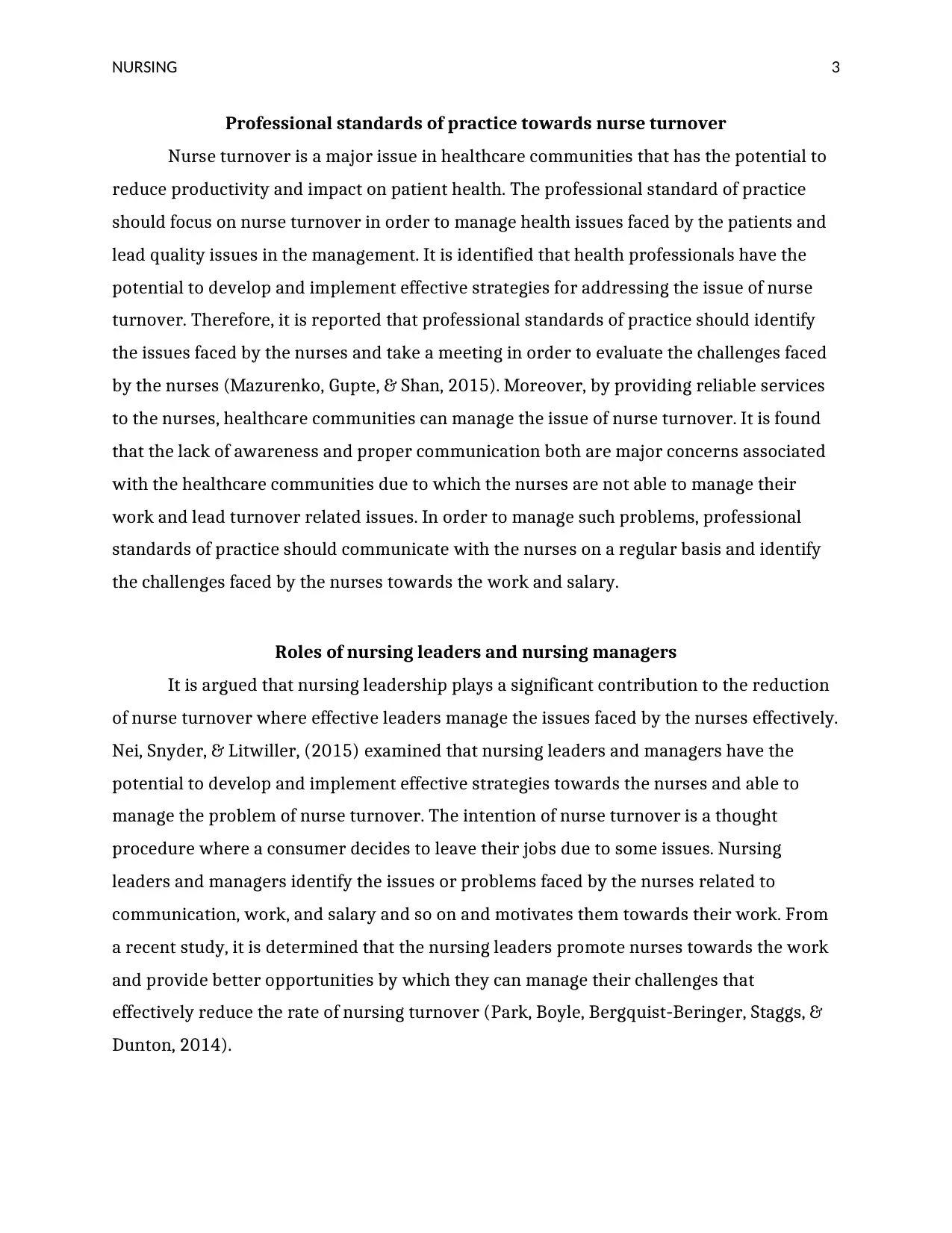
NURSING 3
Professional standards of practice towards nurse turnover
Nurse turnover is a major issue in healthcare communities that has the potential to
reduce productivity and impact on patient health. The professional standard of practice
should focus on nurse turnover in order to manage health issues faced by the patients and
lead quality issues in the management. It is identified that health professionals have the
potential to develop and implement effective strategies for addressing the issue of nurse
turnover. Therefore, it is reported that professional standards of practice should identify
the issues faced by the nurses and take a meeting in order to evaluate the challenges faced
by the nurses (Mazurenko, Gupte, & Shan, 2015). Moreover, by providing reliable services
to the nurses, healthcare communities can manage the issue of nurse turnover. It is found
that the lack of awareness and proper communication both are major concerns associated
with the healthcare communities due to which the nurses are not able to manage their
work and lead turnover related issues. In order to manage such problems, professional
standards of practice should communicate with the nurses on a regular basis and identify
the challenges faced by the nurses towards the work and salary.
Roles of nursing leaders and nursing managers
It is argued that nursing leadership plays a significant contribution to the reduction
of nurse turnover where effective leaders manage the issues faced by the nurses effectively.
Nei, Snyder, & Litwiller, (2015) examined that nursing leaders and managers have the
potential to develop and implement effective strategies towards the nurses and able to
manage the problem of nurse turnover. The intention of nurse turnover is a thought
procedure where a consumer decides to leave their jobs due to some issues. Nursing
leaders and managers identify the issues or problems faced by the nurses related to
communication, work, and salary and so on and motivates them towards their work. From
a recent study, it is determined that the nursing leaders promote nurses towards the work
and provide better opportunities by which they can manage their challenges that
effectively reduce the rate of nursing turnover (Park, Boyle, Bergquist‐Beringer, Staggs, &
Dunton, 2014).
Professional standards of practice towards nurse turnover
Nurse turnover is a major issue in healthcare communities that has the potential to
reduce productivity and impact on patient health. The professional standard of practice
should focus on nurse turnover in order to manage health issues faced by the patients and
lead quality issues in the management. It is identified that health professionals have the
potential to develop and implement effective strategies for addressing the issue of nurse
turnover. Therefore, it is reported that professional standards of practice should identify
the issues faced by the nurses and take a meeting in order to evaluate the challenges faced
by the nurses (Mazurenko, Gupte, & Shan, 2015). Moreover, by providing reliable services
to the nurses, healthcare communities can manage the issue of nurse turnover. It is found
that the lack of awareness and proper communication both are major concerns associated
with the healthcare communities due to which the nurses are not able to manage their
work and lead turnover related issues. In order to manage such problems, professional
standards of practice should communicate with the nurses on a regular basis and identify
the challenges faced by the nurses towards the work and salary.
Roles of nursing leaders and nursing managers
It is argued that nursing leadership plays a significant contribution to the reduction
of nurse turnover where effective leaders manage the issues faced by the nurses effectively.
Nei, Snyder, & Litwiller, (2015) examined that nursing leaders and managers have the
potential to develop and implement effective strategies towards the nurses and able to
manage the problem of nurse turnover. The intention of nurse turnover is a thought
procedure where a consumer decides to leave their jobs due to some issues. Nursing
leaders and managers identify the issues or problems faced by the nurses related to
communication, work, and salary and so on and motivates them towards their work. From
a recent study, it is determined that the nursing leaders promote nurses towards the work
and provide better opportunities by which they can manage their challenges that
effectively reduce the rate of nursing turnover (Park, Boyle, Bergquist‐Beringer, Staggs, &
Dunton, 2014).
Paraphrase This Document
Need a fresh take? Get an instant paraphrase of this document with our AI Paraphraser
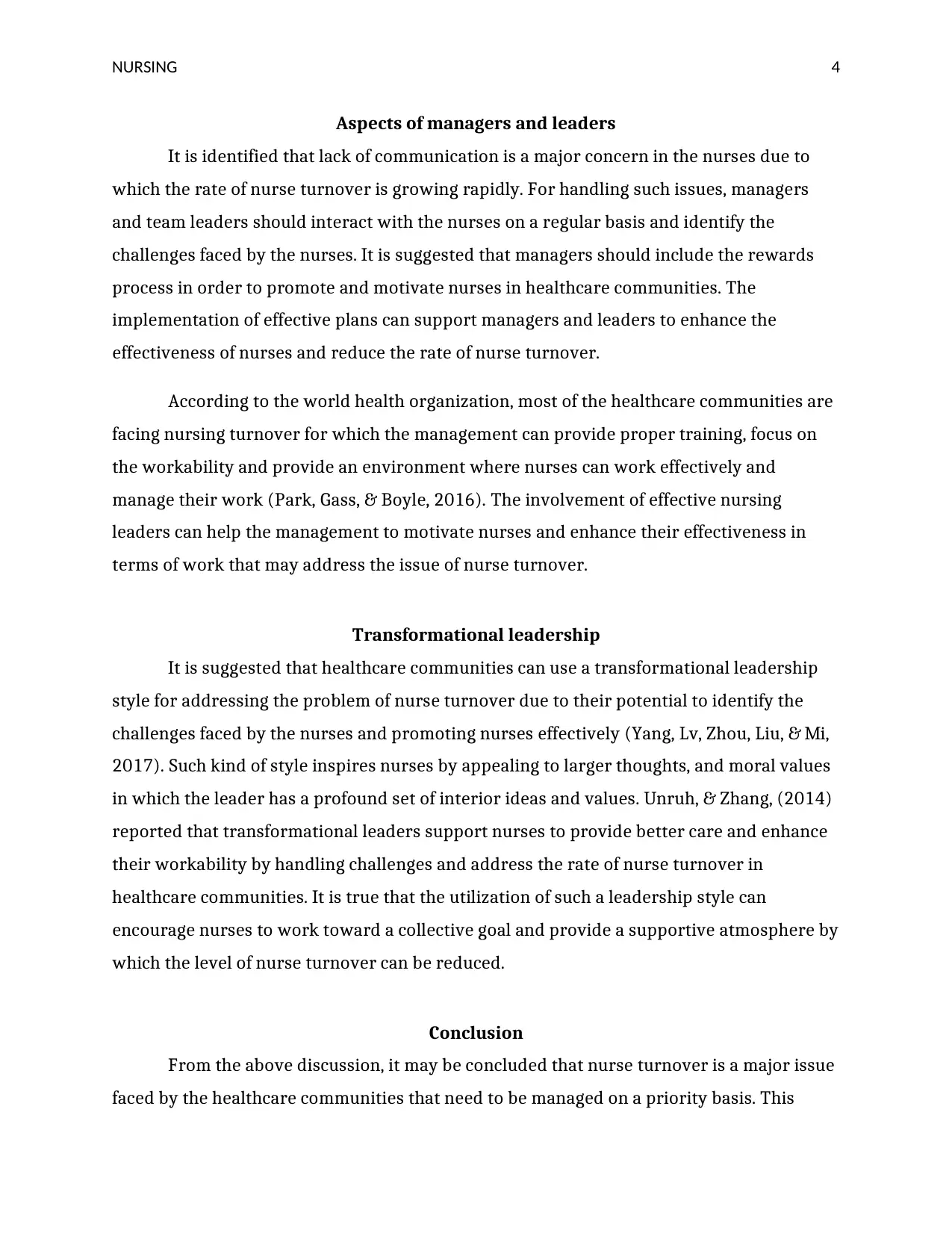
NURSING 4
Aspects of managers and leaders
It is identified that lack of communication is a major concern in the nurses due to
which the rate of nurse turnover is growing rapidly. For handling such issues, managers
and team leaders should interact with the nurses on a regular basis and identify the
challenges faced by the nurses. It is suggested that managers should include the rewards
process in order to promote and motivate nurses in healthcare communities. The
implementation of effective plans can support managers and leaders to enhance the
effectiveness of nurses and reduce the rate of nurse turnover.
According to the world health organization, most of the healthcare communities are
facing nursing turnover for which the management can provide proper training, focus on
the workability and provide an environment where nurses can work effectively and
manage their work (Park, Gass, & Boyle, 2016). The involvement of effective nursing
leaders can help the management to motivate nurses and enhance their effectiveness in
terms of work that may address the issue of nurse turnover.
Transformational leadership
It is suggested that healthcare communities can use a transformational leadership
style for addressing the problem of nurse turnover due to their potential to identify the
challenges faced by the nurses and promoting nurses effectively (Yang, Lv, Zhou, Liu, & Mi,
2017). Such kind of style inspires nurses by appealing to larger thoughts, and moral values
in which the leader has a profound set of interior ideas and values. Unruh, & Zhang, (2014)
reported that transformational leaders support nurses to provide better care and enhance
their workability by handling challenges and address the rate of nurse turnover in
healthcare communities. It is true that the utilization of such a leadership style can
encourage nurses to work toward a collective goal and provide a supportive atmosphere by
which the level of nurse turnover can be reduced.
Conclusion
From the above discussion, it may be concluded that nurse turnover is a major issue
faced by the healthcare communities that need to be managed on a priority basis. This
Aspects of managers and leaders
It is identified that lack of communication is a major concern in the nurses due to
which the rate of nurse turnover is growing rapidly. For handling such issues, managers
and team leaders should interact with the nurses on a regular basis and identify the
challenges faced by the nurses. It is suggested that managers should include the rewards
process in order to promote and motivate nurses in healthcare communities. The
implementation of effective plans can support managers and leaders to enhance the
effectiveness of nurses and reduce the rate of nurse turnover.
According to the world health organization, most of the healthcare communities are
facing nursing turnover for which the management can provide proper training, focus on
the workability and provide an environment where nurses can work effectively and
manage their work (Park, Gass, & Boyle, 2016). The involvement of effective nursing
leaders can help the management to motivate nurses and enhance their effectiveness in
terms of work that may address the issue of nurse turnover.
Transformational leadership
It is suggested that healthcare communities can use a transformational leadership
style for addressing the problem of nurse turnover due to their potential to identify the
challenges faced by the nurses and promoting nurses effectively (Yang, Lv, Zhou, Liu, & Mi,
2017). Such kind of style inspires nurses by appealing to larger thoughts, and moral values
in which the leader has a profound set of interior ideas and values. Unruh, & Zhang, (2014)
reported that transformational leaders support nurses to provide better care and enhance
their workability by handling challenges and address the rate of nurse turnover in
healthcare communities. It is true that the utilization of such a leadership style can
encourage nurses to work toward a collective goal and provide a supportive atmosphere by
which the level of nurse turnover can be reduced.
Conclusion
From the above discussion, it may be concluded that nurse turnover is a major issue
faced by the healthcare communities that need to be managed on a priority basis. This
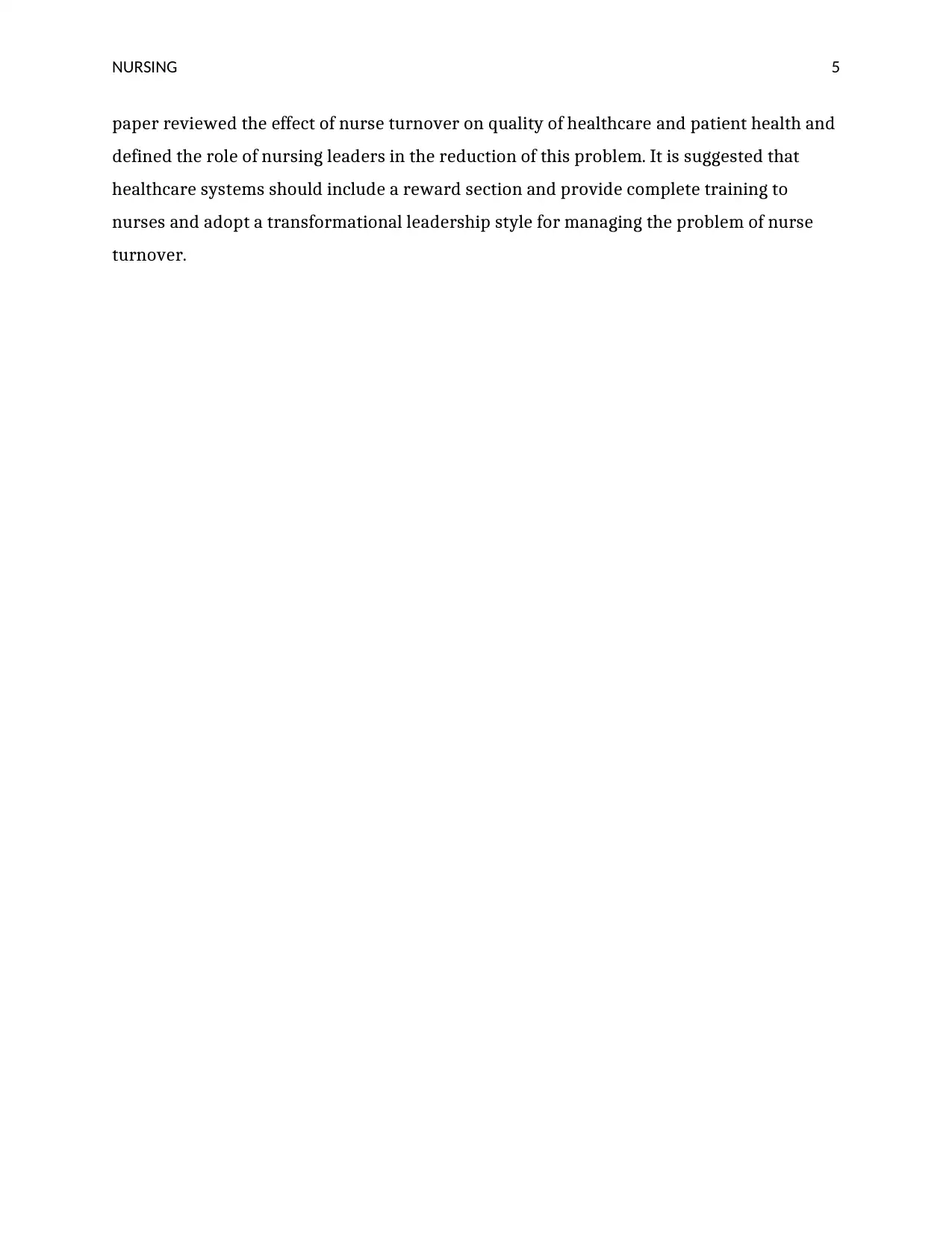
NURSING 5
paper reviewed the effect of nurse turnover on quality of healthcare and patient health and
defined the role of nursing leaders in the reduction of this problem. It is suggested that
healthcare systems should include a reward section and provide complete training to
nurses and adopt a transformational leadership style for managing the problem of nurse
turnover.
paper reviewed the effect of nurse turnover on quality of healthcare and patient health and
defined the role of nursing leaders in the reduction of this problem. It is suggested that
healthcare systems should include a reward section and provide complete training to
nurses and adopt a transformational leadership style for managing the problem of nurse
turnover.
⊘ This is a preview!⊘
Do you want full access?
Subscribe today to unlock all pages.

Trusted by 1+ million students worldwide
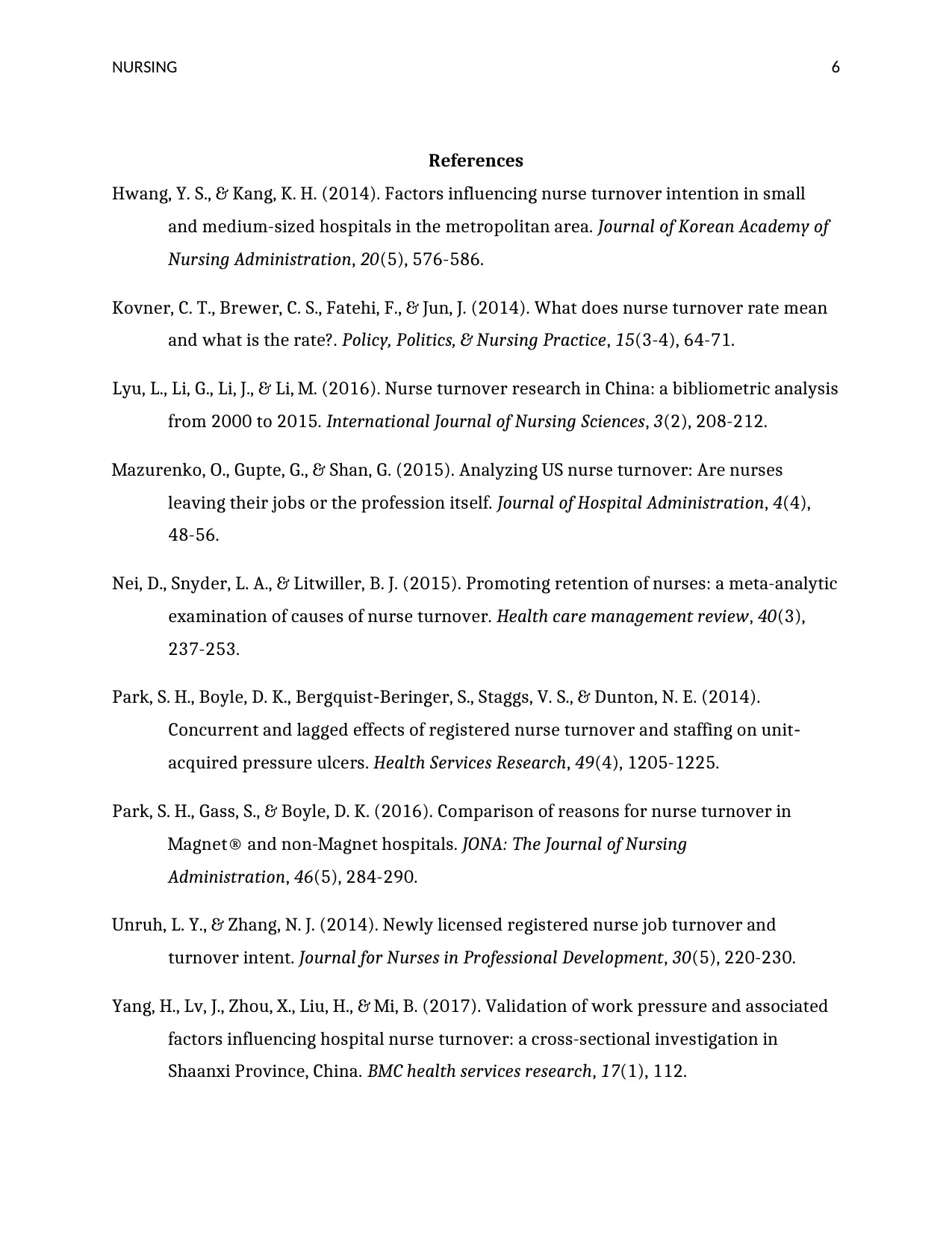
NURSING 6
References
Hwang, Y. S., & Kang, K. H. (2014). Factors influencing nurse turnover intention in small
and medium-sized hospitals in the metropolitan area. Journal of Korean Academy of
Nursing Administration, 20(5), 576-586.
Kovner, C. T., Brewer, C. S., Fatehi, F., & Jun, J. (2014). What does nurse turnover rate mean
and what is the rate?. Policy, Politics, & Nursing Practice, 15(3-4), 64-71.
Lyu, L., Li, G., Li, J., & Li, M. (2016). Nurse turnover research in China: a bibliometric analysis
from 2000 to 2015. International Journal of Nursing Sciences, 3(2), 208-212.
Mazurenko, O., Gupte, G., & Shan, G. (2015). Analyzing US nurse turnover: Are nurses
leaving their jobs or the profession itself. Journal of Hospital Administration, 4(4),
48-56.
Nei, D., Snyder, L. A., & Litwiller, B. J. (2015). Promoting retention of nurses: a meta-analytic
examination of causes of nurse turnover. Health care management review, 40(3),
237-253.
Park, S. H., Boyle, D. K., Bergquist‐Beringer, S., Staggs, V. S., & Dunton, N. E. (2014).
Concurrent and lagged effects of registered nurse turnover and staffing on unit‐
acquired pressure ulcers. Health Services Research, 49(4), 1205-1225.
Park, S. H., Gass, S., & Boyle, D. K. (2016). Comparison of reasons for nurse turnover in
Magnet® and non-Magnet hospitals. JONA: The Journal of Nursing
Administration, 46(5), 284-290.
Unruh, L. Y., & Zhang, N. J. (2014). Newly licensed registered nurse job turnover and
turnover intent. Journal for Nurses in Professional Development, 30(5), 220-230.
Yang, H., Lv, J., Zhou, X., Liu, H., & Mi, B. (2017). Validation of work pressure and associated
factors influencing hospital nurse turnover: a cross-sectional investigation in
Shaanxi Province, China. BMC health services research, 17(1), 112.
References
Hwang, Y. S., & Kang, K. H. (2014). Factors influencing nurse turnover intention in small
and medium-sized hospitals in the metropolitan area. Journal of Korean Academy of
Nursing Administration, 20(5), 576-586.
Kovner, C. T., Brewer, C. S., Fatehi, F., & Jun, J. (2014). What does nurse turnover rate mean
and what is the rate?. Policy, Politics, & Nursing Practice, 15(3-4), 64-71.
Lyu, L., Li, G., Li, J., & Li, M. (2016). Nurse turnover research in China: a bibliometric analysis
from 2000 to 2015. International Journal of Nursing Sciences, 3(2), 208-212.
Mazurenko, O., Gupte, G., & Shan, G. (2015). Analyzing US nurse turnover: Are nurses
leaving their jobs or the profession itself. Journal of Hospital Administration, 4(4),
48-56.
Nei, D., Snyder, L. A., & Litwiller, B. J. (2015). Promoting retention of nurses: a meta-analytic
examination of causes of nurse turnover. Health care management review, 40(3),
237-253.
Park, S. H., Boyle, D. K., Bergquist‐Beringer, S., Staggs, V. S., & Dunton, N. E. (2014).
Concurrent and lagged effects of registered nurse turnover and staffing on unit‐
acquired pressure ulcers. Health Services Research, 49(4), 1205-1225.
Park, S. H., Gass, S., & Boyle, D. K. (2016). Comparison of reasons for nurse turnover in
Magnet® and non-Magnet hospitals. JONA: The Journal of Nursing
Administration, 46(5), 284-290.
Unruh, L. Y., & Zhang, N. J. (2014). Newly licensed registered nurse job turnover and
turnover intent. Journal for Nurses in Professional Development, 30(5), 220-230.
Yang, H., Lv, J., Zhou, X., Liu, H., & Mi, B. (2017). Validation of work pressure and associated
factors influencing hospital nurse turnover: a cross-sectional investigation in
Shaanxi Province, China. BMC health services research, 17(1), 112.
Paraphrase This Document
Need a fresh take? Get an instant paraphrase of this document with our AI Paraphraser

NURSING 7
1 out of 8
Related Documents
Your All-in-One AI-Powered Toolkit for Academic Success.
+13062052269
info@desklib.com
Available 24*7 on WhatsApp / Email
![[object Object]](/_next/static/media/star-bottom.7253800d.svg)
Unlock your academic potential
Copyright © 2020–2025 A2Z Services. All Rights Reserved. Developed and managed by ZUCOL.





